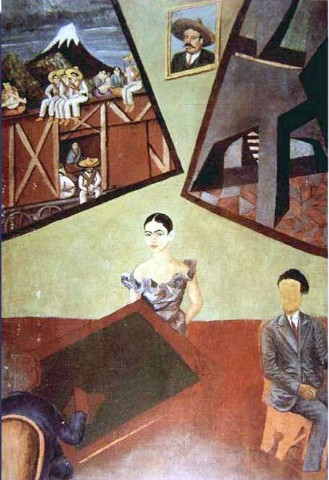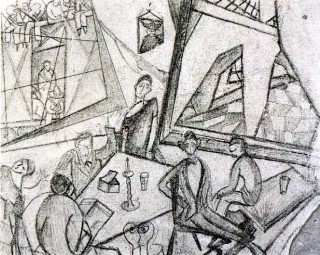The
Adelita, Pancho Villa
and Frida
1927
After recovering from her near fatal bus accident, Frida was once again with her old schoolmates. She began to get involved with politics, following revolutionary ideas and rediscovering her Mexican roots. In this primitive "Cubist" style painting, she portrays herself in the center, with a portrait of the revolutionary leader Pancho Villa above. She is flanked by two pictures of very different styles and themes. The one to her right is a convoy of revolutionary Zapatistas and their "soldieras" women "Adelitas" crossing the valley of Mexico. In the background is Mexico's famous volcano, Popocatpetl. The other picture to her left is a modern abstract view through an architectural structure across a tiled floor. In this painting she seems to try to combine both ideas, the Revolution and Mexicanism. She is using the popular song "The Adelita" as part of the title for this painting. "Adelita" is a camp-following young woman who bewails the departure of her soldier lover.
The theme of this painting was influenced by "estridentismo", a recent movement in Mexico whose purpose was to develop social awareness and express rebellion against the system. Although the movement was primarily a literary trend it soon found its way onto the canvas. Artist who embraced the "estridentismo" movement would often meet in city cafes to discuss their ideas. This painting was intended to depict one such group meeting.
Before starting this painting, Frida first drew a pencil sketch. The sketch was much more detailed and complex and very different from the painting that followed. Missing from the painting are most of the group members. Only one, a faceless man, appears in the painting along with Frida. These differences suggest that the painting is an unfinished work.

Oil
on canvas mounted on board
25 5/8" x 17 3/4"
Tlaxcalteca Institute of Culture
Tlaxcala, Mexico
Óleo sobre lienzo montado
sobre madera
65 x 45 cm.
Instituto Tlaxcalteca
de Cultura
Tlaxcala, México

Pencil
Sketch Study
estudio del bosquejo del lápiz
La Adelita,
Pancho Villa
y Frida
1927
Después de recuperase del casi fatal accidente de autobús, Frida volvió de nuevo con sus antiguos compañeros de escuela. Empezó a involucrarse con política, siguiendo ideas revolucionarias y redescubriendo sus raíces Mexicanas. Con este estilo primitivo cubista que utilizaba en esta etapa, Frida se pintó en el centro de este cuadro, con un retrato del líder revolucionario Pancho Villa. A cada lado de Frida hay dos fotos de diferentes estilos y temas. A su derecha hay un convoy de revolucionarios Zapatistas y sus mujeres soldados "Adelitas", cruzando el valle de México. En el fondo esta el famoso volcán mexicano Popocatpetl. A su izquierda hay una vista moderna abstracta a través de una estructura arquitectónica a través de un suelo de azulejos. En este retrato parece estar combinando ambas ideas, la Revolución y el Mexicanismo. Usa una canción popular, "La Adelita" como parte del título para este retrato. "Adelita" es una joven mujer que marcha con las tropas siguiendo a su amado.
El tema de esta pintura fue influenciada por el "estridentismo", por entonces un reciente movimiento en México cuya idea era desarrollar conciencia social y expresar rebelión contra el sistema. Aunque el movimiento era principalmente una tendencia literaria, pronto se coló en la pintura. Los artistas que abrazaron el movimiento del "estridentismo" a menudo se reunían en cafés de la ciudad para discutir sus ideas. Este retrato pretendía mostrar una de estas reuniones del grupo.
Antes de empezar este retrato, Frida hizo un esbozo a lápiz. El esbozo era mucho más detallado y complejo y muy diferente de la pintura que seguiría. La mayor parte de los miembros del grupo no aparecen en el retrato. Solo uno, un hombre sin cara, aparece en el retrato con Frida. Estas diferencias podrían significar que la pintura es un trabajo inacabado.